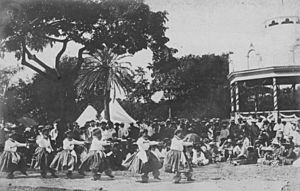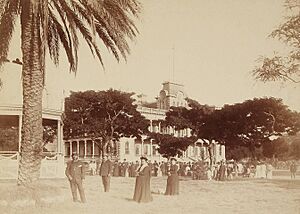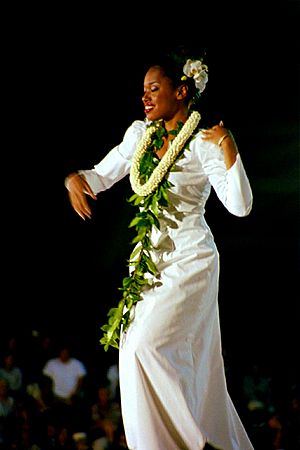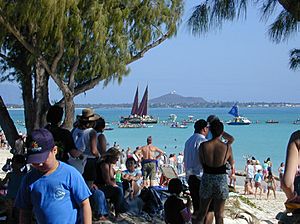Hawaiian Renaissance facts for kids
The Hawaiian Renaissance (also known as the Hawaiian Cultural Renaissance) was a special time when people in Hawaii rediscovered and celebrated their unique culture. It helped bring back traditional Hawaiian ways of life. This movement moved away from the tourism-focused culture that was popular before. The Hawaiian Renaissance is seen as a great example for bringing back nature and culture together. It also shows how to live in a sustainable way.
Contents
The First Hawaiian Renaissance
The First Hawaiian Renaissance began with King Kamehameha V. At this time, Hawaii was an independent kingdom. The goal was to create a strong Hawaiian national identity. This identity was not meant to copy Great Britain or the United States.
King Kalākaua became king after some disagreements. But many people came to support him. He helped bring Hawaiian culture back to the cities.
King Kalākaua's Cultural Efforts
King Kalākaua worked hard to strengthen Hawaiian pride. In 1876, he changed the national anthem. He replaced the Christian song "He Mele Lahui Hawaii" with "Hawaiʻi Ponoʻī". This new anthem was inspired by Kamehameha I. He also had the old ʻIolani Palace rebuilt. Work started in 1879 and finished in 1882.
Kalākaua always put his people first. This sometimes meant disagreeing with the ideas of missionary descendants. These descendants had gained power in Hawaii by buying land. They had important advisory roles to the king.
In 1883, Kalākaua planned his second coronation for three years. He wanted to ease tensions between local people and the missionary descendants. About 8,000 people attended the event.
Reviving Hawaiian Traditions
King Kalākaua supported many traditional Hawaiian practices. These included hula, chants, sports, and royal rituals. He also made sure Hawaiian myths, legends, and chants were written down. An important example is the "Kumulipo". He also had his own family history traced.
The Second Hawaiian Renaissance
The Second Hawaiian Renaissance is thought to have started around 1970. It was inspired by other cultural movements of that time. This period is well-known for its music. Musicians like Gabby Pahinui with the Sons of Hawaii were important. Keola and Kapono Beamer played traditional slack-key music. Other key Hawaiian musicians were Dennis Pavao, Ledward Kaʻapana, and Nedward Kaʻapana. The Kaʻapana brothers and their cousin Pavao formed the singing group Hui ʻOhana. The group "Olomana" also added a lot to the music of this time. They sang songs like 'O Malia' and 'Mele O Kahoolawe'.
Renewed Cultural Interest
This period also saw a strong interest in the Hawaiian language. People also became more interested in Pidgin, Hula, and traditional Hawaiian crafts. There was a growth in Hawaiian Studies programs.
This increase in Hawaiian self-identity was inspired by an essay. In 1964, writer John Dominis Holt IV wrote "On Being Hawaiian." This essay helped bring pride back to being Hawaiian. Before this, there had been many negative stereotypes.
The Merrie Monarch Festival was started in 1964 by Helene Hale. This festival helped bring back the study and practice of ancient hula. This was the hula that existed before 1893.
Land and Voyaging Revival
This era also included important struggles over land. Examples include the Kalama Valley, Kahoʻolawe, and Waiāhole-Waikāne. There was also a return to traditional practices. These included loʻi kalo (taro patch) farming and folk arts. People also focused on mālama ʻāina, which means caring for the land.
Polynesian voyaging is another big part of the Hawaiian Renaissance. In 1975, the Polynesian Voyaging Society built a replica of an ancient Polynesian voyaging canoe. This vessel was named Hōkūle‘a. The return of non-instrument wayfinding navigation was also key. The Hōkūle‘a and its first navigator, Dr. Ben Finney, are symbols of the Hawaiian Renaissance. They helped bring back interest in Polynesian culture. The Hōkūle‘a's most recent voyage ended on June 17, 2017. (See Hōkūle‘a)
Political Impact
The movement sometimes involved politics. It touched on issues for Native Hawaiians. It also focused on bringing back Hawaiian independence. One important result was the Constitution of 1978. This led to the creation of the Office of Hawaiian Affairs. It also helped reclaim federal land for the State, like Kahoolawe.
The peak of the Hawaiian Renaissance is usually seen as the 1970s. It mostly slowed down by 1980. However, some people still see it as an ongoing movement today.
The term "Hawaiian Renaissance" is also sometimes used for the time right after King Kalākaua became king. This period saw the public return of traditional arts like the hula. These arts had been forced underground for decades by Calvinist missionaries.
See also
 In Spanish: Renacimiento hawaiano para niños
In Spanish: Renacimiento hawaiano para niños





